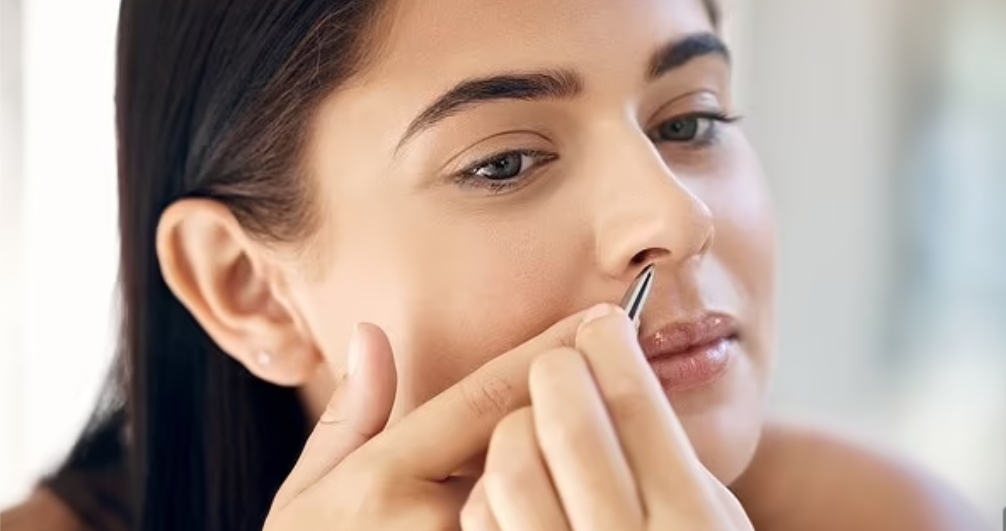Nasal hair problems and solutions are more common than many people realize. Nasal hair plays a vital role in protecting your respiratory system by trapping dust, allergens, and bacteria.
However, when these hairs become overly long, thick, or ingrown, they can cause discomfort, embarrassment, or even health concerns.
Understanding how to manage these issues without disrupting the natural function of nasal hair is essential for both hygiene and appearance.
Common Nasal Hair Problems
According to the British Journal of Dermatology, many people experience one or more of the following nasal hair issues:
| Problem | Description |
| Overgrowth | Nasal hairs grow long enough to protrude from the nostrils |
| Ingrown hairs | A hair grows back into the skin, leading to irritation or infection |
| Dryness and irritation | Caused by excessive trimming or dry air |
| Infection | Bacteria enter the follicle, causing redness, swelling, or pus formation |
Each problem can range from a minor annoyance to a more serious concern, especially if ignored.
Trimming is better than plucking — it reduces irritation and prevents ingrown hairs.
Learn more about nose hair permanent removal here.
Effective Solutions for Nasal Hair Problems
The good news is that there are practical ways to handle nasal hair problems without causing further damage or discomfort.
1. Trimming the Right Way
Using rounded-tip scissors or an electric nasal hair trimmer is the safest method. Never use regular scissors or sharp blades near your nose, as the skin is delicate and prone to injury.
Best Practices:
- Use a magnifying mirror and good lighting
- Only trim visible hairs
- Clean your trimmer regularly to avoid bacterial buildup
Learn more about how to trim nose hair for women here.
2. Avoid Plucking
Plucking nasal hairs with tweezers can damage hair follicles and create an open path for bacteria, increasing the risk of infection or painful ingrown hairs.
3. Moisturize the Nasal Lining
Dry nasal passages can become irritated, especially during winter or in air-conditioned environments.
Using a saline spray or a gentle nasal moisturizer can help maintain a healthy inner lining and reduce itching or flaking.
Learn more about how to cut nose hair without a trimmer here.
4. Laser Hair Removal (For Chronic Overgrowth)
Laser hair removal is a semi-permanent solution for those who experience frequent nasal hair overgrowth.
This method must be done by a licensed professional. Only certain hairs close to the nasal entrance can be safely treated this way.
5. Antibacterial Cream for Infections
If you notice swelling, redness, or pain inside your nose, especially after grooming, you may have an infection. Over-the-counter antibacterial creams can help, but persistent issues require medical attention.
If there’s pain or pus, it’s time to pause the grooming and focus on healing.
Learn more about how to treat sunburn on a dog’s nose here.
Summary Table: Nasal Hair Problems and Solutions
| Problem | Cause | Solution |
| Overgrowth | Natural growth, aging | Trim with safe tools |
| Ingrown hairs | Plucking or tight trimming | Warm compress, avoid plucking |
| Dryness | Lack of humidity or overcleaning | Saline spray, gentle moisturizer |
| Infections | Bacteria from grooming | Antibacterial cream or medical treatment |
Learn more about parkinson’s and runny nose symptoms here.
When to Seek Medical Attention
Not every nasal hair problem needs a doctor’s visit. But some situations require expert care. You should see a doctor if:
- You notice pus, bleeding, or swelling that doesn’t go away
- Pain increases over several days
- You develop a fever after grooming your nose
- An ingrown hair forms a painful lump
These could indicate a deeper infection or abscess that might need antibiotics or drainage.
Learn more about how to stop a runny nose and watery eyes fast here.
What to Expect at the Doctor’s Office
Doctors will typically:
- Inspect the nasal passage with a light and possibly a nasal speculum
- Ask about your grooming habits
- Recommend antibacterial treatment or minor in-office procedures for infections
- Refer you to a dermatologist or ENT specialist for chronic or recurring issues
In rare cases, if nasal folliculitis (infection of hair follicles) is suspected, a swab might be taken for lab testing to determine the right antibiotic.
Learn more about can whole grain bread can cause bloating here.
A Word from GetMe Treated
Managing nasal hair doesn’t have to be complicated or painful. With the right grooming methods and awareness, you can address nasal hair problems and solutions effectively. Always prioritize safety and hygiene, and don’t hesitate to seek medical advice if anything seems unusual.
FAQs About Nasal Hair Problems and Solutions
Is it bad to have nasal hair?
No, nasal hair is important for filtering particles and protecting your lungs. Only visible or overly long hair should be trimmed.
Can trimming nasal hair cause infection?
Not if done properly. Always use clean tools and avoid cutting too close to the skin.
How often should I trim my nasal hair?
Most people only need to trim every 1–2 weeks. Trimming more frequently can irritate the skin.
What causes nasal hair to grow faster?
Hormonal changes, age, and genetics all influence hair growth. Some people naturally have thicker or faster-growing nasal hair.
Is laser hair removal safe for nose hair?
It can be safe for the outer part of the nostrils, but it should only be done by a trained professional. Never attempt this at home.
Why do I get ingrown nasal hairs?
This usually happens from plucking or improper trimming. The hair curls back into the skin, causing inflammation or infection.

